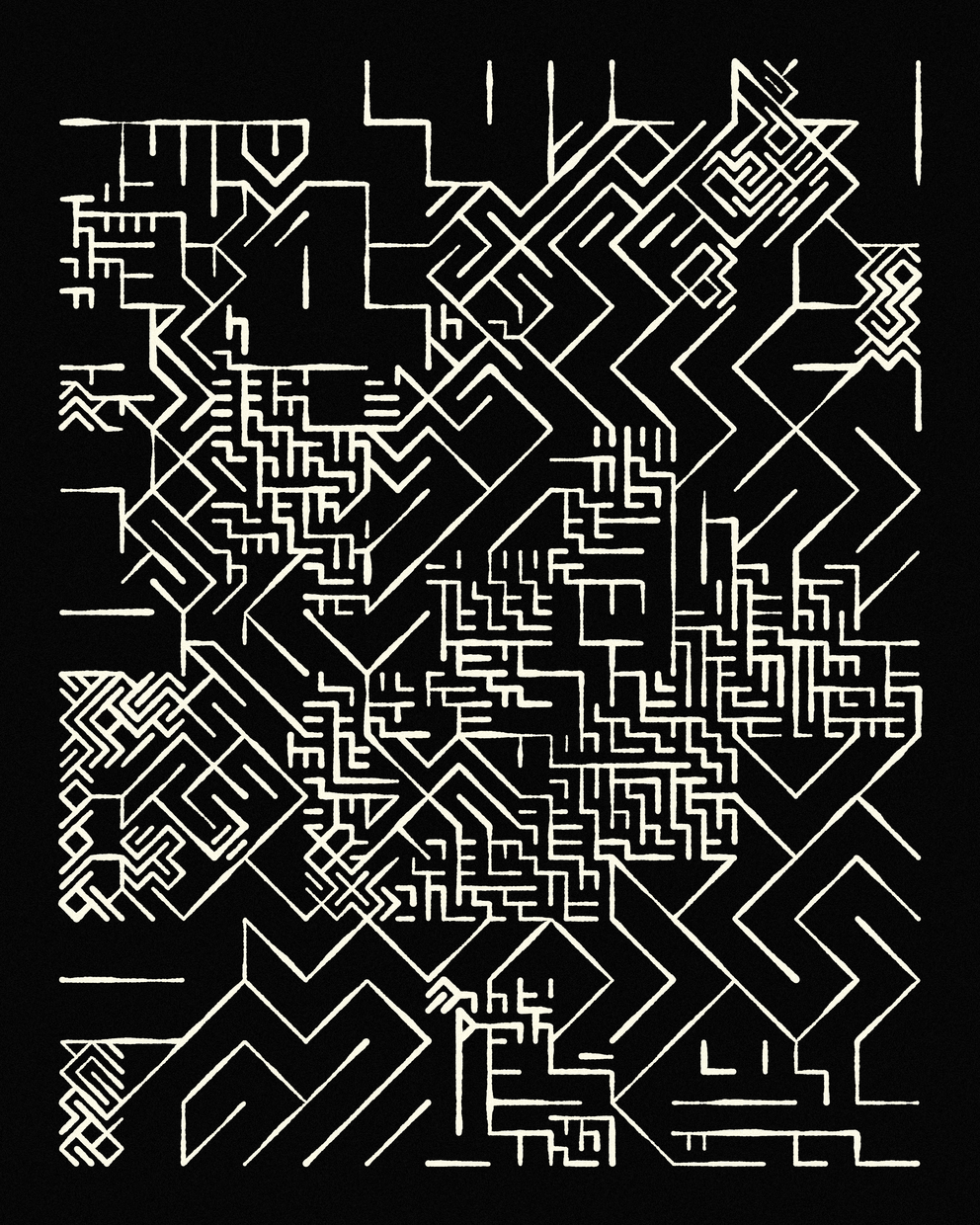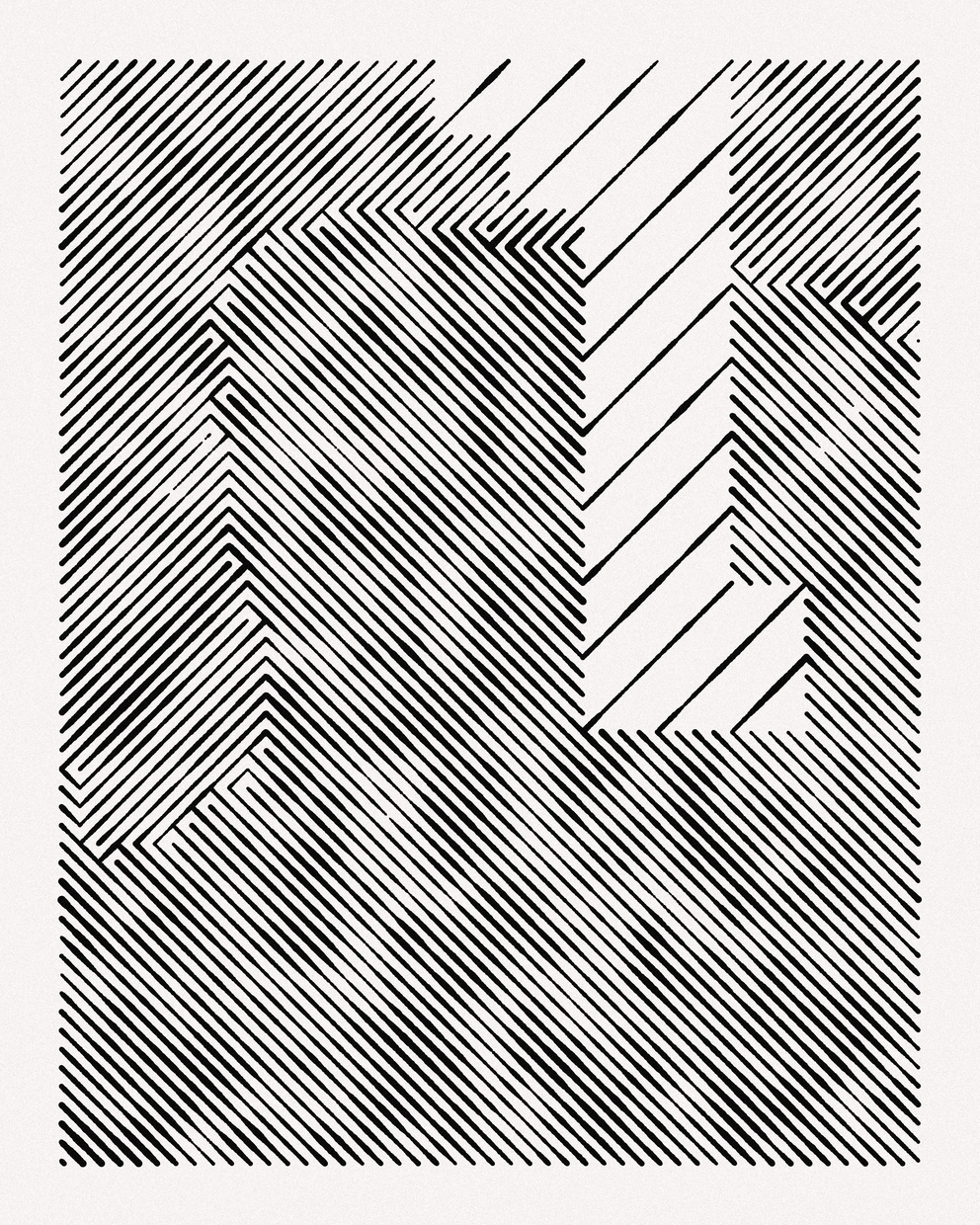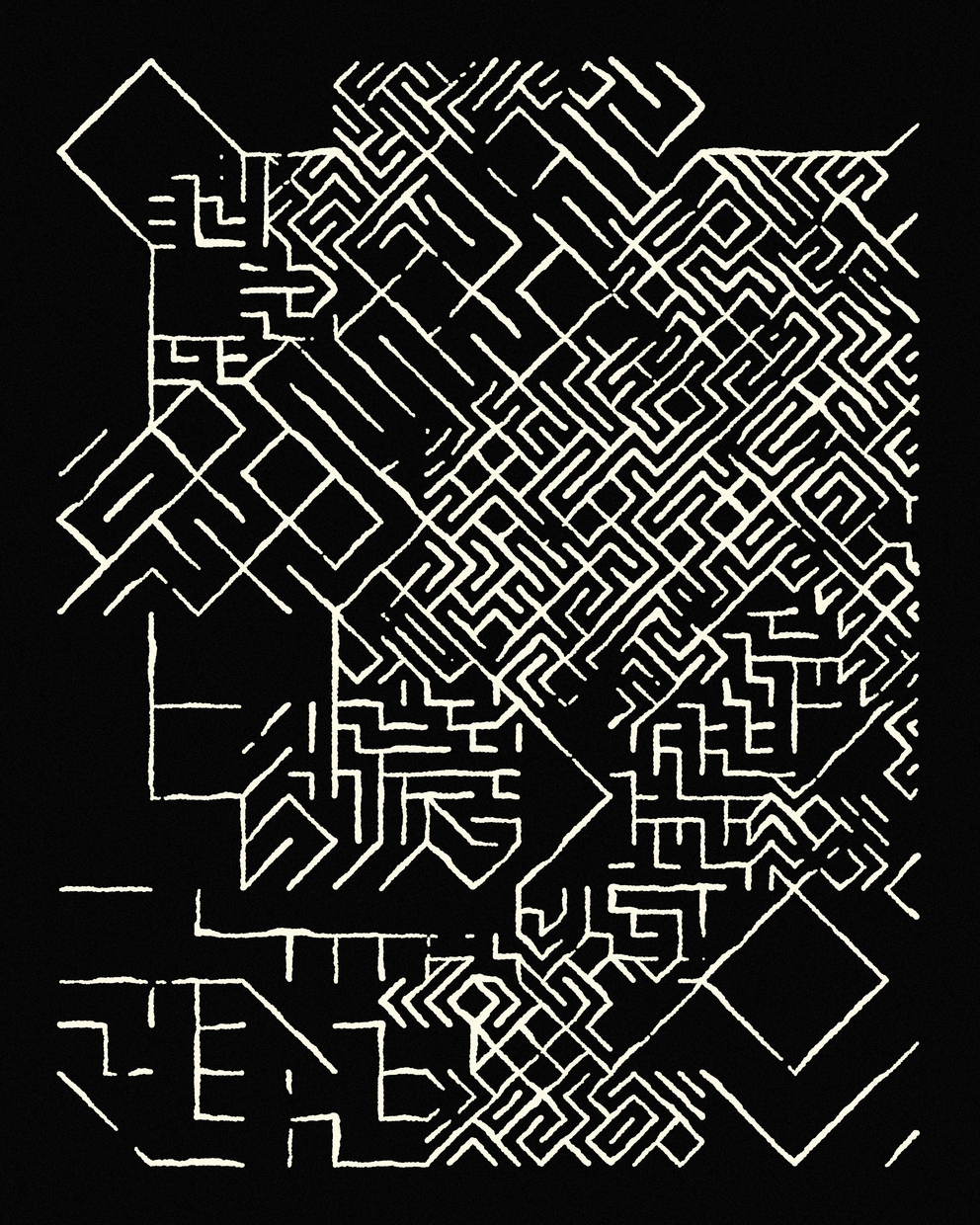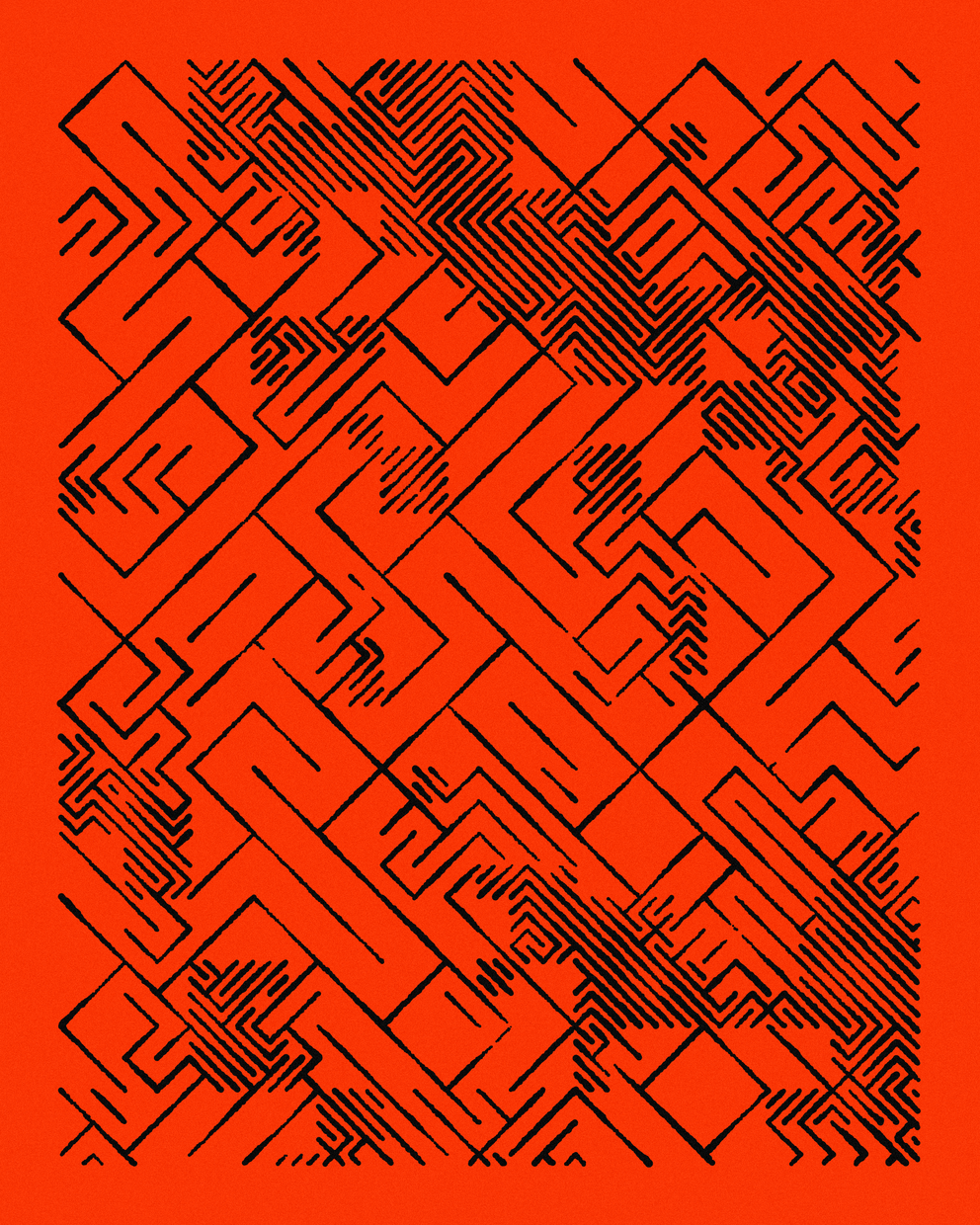by Gorilla Sun
Daze Maze
IPFS
PARAMS

22 March 2023•TEZOS•IPFS
A recursive homage to the iconic 10 print pattern.
This one started as a late night exploration starting from a simple snippet of code, iteratively adding complexity to it until I was able to generate a variety of different patterns.
+ - - - - - +
This token implements FxParams, and the way I decided to go about it is a bit special. When you mint this token you get what you see - WYSIWYG! - What you see is what you get! - this is done by overriding the hash injected into the code and locking p5's randomness and noise seed manually as parameters.
Therefore, before you start tweaking these values, put the sliders at some random position for the noise and randomness seeds.
To reiterate:
- The first two parameters are in place to override the hash that fxhash injects into the code!
- This is to ensure that the token you ultimately mint is exactly the same as the token you composed for yourself by tweaking the parameters.
- I recommend setting them to something random at the beginning, and then have fun changing the parameters.
- Duplicates are technically possible if you set the random and noise seed to the same value as another person. But I don't see a good reason why you would want to do that. If you really want two mints that look exactly the same, that is also possible and I also don't see a reason why you shouldn't be able to do this.
+ - - - - - +
The Parameters:
1. Stroke Orientation: there's three different types of stroke orientation, which essentially determine how the lines in the artwork are slanted:
- RIGHT: Horizontal and vertical strokes.
- ANGLED: slanted forward and backward strokes.
- MIXED: A combination of the two previous modes.
2. Stroke Noise Frequency: the mechanism that decides if a stroke is slanted in a vertical or horizontal (alternatively slanted forward or backward), is based on an underlying perlin noise value. The higher the frequency of this noise, the more turbulently the strokes will alternate direction. Lower values produce smoother structures.
3. Recursion Noise Frequency: Similarly to the previous parameter, a different noise value determines if the will be a recursive step creating a shorter and denser breakup of the lines. A higher frequency means that these breaks are more turbulent and more frequent and vice versa
4. Density: Simply a parameter that controls the distance between the lines.
5. Color Combo: Determines the colors applied to the artwork. There's three different options here.
5. Invert Colors: A toogle that allows the inversion of the color scheme. Background color becomes stroke color and vice versa.
6. Stroke Wobble: The higher this value the more swung the resulting lines are.
7. Scribble Amount: determines the scribbliness of the lines. The higher this parameter is the more scribbly the lines are.
8. Discontinuity Threshold: Controls the amount of discontinuity in the lines. A higher value means that there will be more gaps between the lines.
This one started as a late night exploration starting from a simple snippet of code, iteratively adding complexity to it until I was able to generate a variety of different patterns.
+ - - - - - +
This token implements FxParams, and the way I decided to go about it is a bit special. When you mint this token you get what you see - WYSIWYG! - What you see is what you get! - this is done by overriding the hash injected into the code and locking p5's randomness and noise seed manually as parameters.
Therefore, before you start tweaking these values, put the sliders at some random position for the noise and randomness seeds.
To reiterate:
- The first two parameters are in place to override the hash that fxhash injects into the code!
- This is to ensure that the token you ultimately mint is exactly the same as the token you composed for yourself by tweaking the parameters.
- I recommend setting them to something random at the beginning, and then have fun changing the parameters.
- Duplicates are technically possible if you set the random and noise seed to the same value as another person. But I don't see a good reason why you would want to do that. If you really want two mints that look exactly the same, that is also possible and I also don't see a reason why you shouldn't be able to do this.
+ - - - - - +
The Parameters:
1. Stroke Orientation: there's three different types of stroke orientation, which essentially determine how the lines in the artwork are slanted:
- RIGHT: Horizontal and vertical strokes.
- ANGLED: slanted forward and backward strokes.
- MIXED: A combination of the two previous modes.
2. Stroke Noise Frequency: the mechanism that decides if a stroke is slanted in a vertical or horizontal (alternatively slanted forward or backward), is based on an underlying perlin noise value. The higher the frequency of this noise, the more turbulently the strokes will alternate direction. Lower values produce smoother structures.
3. Recursion Noise Frequency: Similarly to the previous parameter, a different noise value determines if the will be a recursive step creating a shorter and denser breakup of the lines. A higher frequency means that these breaks are more turbulent and more frequent and vice versa
4. Density: Simply a parameter that controls the distance between the lines.
5. Color Combo: Determines the colors applied to the artwork. There's three different options here.
5. Invert Colors: A toogle that allows the inversion of the color scheme. Background color becomes stroke color and vice versa.
6. Stroke Wobble: The higher this value the more swung the resulting lines are.
7. Scribble Amount: determines the scribbliness of the lines. The higher this parameter is the more scribbly the lines are.
8. Discontinuity Threshold: Controls the amount of discontinuity in the lines. A higher value means that there will be more gaps between the lines.
Music and computer nerd. Plays guitar. Enjoys programming.
Twitter: @gorillasu
Blog: gorillasun.de
Lorem ipsum project longer longer
0.00001 ETH
Lorem ipsum project longer longer
0.00001 ETH
Lorem ipsum project longer longer
0.00001 ETH
Lorem ipsum project longer longer
0.00001 ETH
Lorem ipsum project longer longer
0.00001 ETH
Lorem ipsum project longer longer
0.00001 ETH
Lorem ipsum project longer longer
0.00001 ETH
Lorem ipsum project longer longer
0.00001 ETH
Lorem ipsum project longer longer
0.00001 ETH
Lorem ipsum project longer longer
0.00001 ETH
Lorem ipsum project longer longer
0.00001 ETH
Lorem ipsum project longer longer
0.00001 ETH
Lorem ipsum project longer longer
0.00001 ETH
Lorem ipsum project longer longer
0.00001 ETH
Lorem ipsum project longer longer
0.00001 ETH
Lorem ipsum project longer longer
0.00001 ETH
Lorem ipsum project longer longer
0.00001 ETH
Lorem ipsum project longer longer
0.00001 ETH
Lorem ipsum project longer longer
0.00001 ETH
Lorem ipsum project longer longer
0.00001 ETH
Lorem ipsum project longer longer
0.00001 ETH
Lorem ipsum project longer longer
0.00001 ETH
Lorem ipsum project longer longer
0.00001 ETH
Lorem ipsum project longer longer
0.00001 ETH























